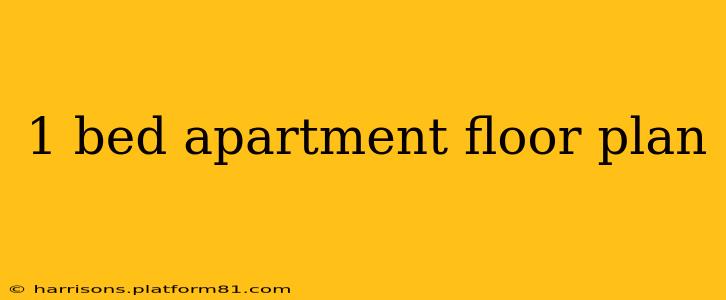Finding the perfect one-bedroom apartment can feel like searching for a needle in a haystack. Understanding floor plans is crucial to ensure you find a space that suits your lifestyle and needs. This guide will explore different aspects of 1-bedroom apartment floor plans, helping you navigate your search and make an informed decision.
What to Look for in a 1-Bedroom Apartment Floor Plan
Before diving into specifics, let's outline key features to consider when reviewing floor plans:
- Square Footage: While a larger square footage is generally preferable, consider how efficiently the space is used. A smaller, well-designed apartment can feel more spacious than a larger, poorly laid-out one.
- Layout: An open-concept floor plan can make a small space feel larger, while a more traditional layout offers more privacy. Consider your personal preference and lifestyle.
- Kitchen & Bathroom Size: Are these areas functional enough for your needs? Consider storage space and counter space in the kitchen, and sufficient space in the bathroom for your toiletries and getting ready.
- Bedroom Size and Closet Space: Ensure the bedroom is large enough for your furniture and provides ample closet space.
- Natural Light: Consider the placement of windows and how much natural light enters the apartment. This can greatly impact the mood and feel of the space.
- Storage: Storage is often a limited commodity in smaller apartments. Look for floor plans that incorporate built-in storage solutions or ample closet space.
Common 1-Bedroom Apartment Floor Plan Layouts
Several common layouts exist for 1-bedroom apartments, each with its pros and cons:
- Open-Concept: This layout combines the living room, dining area, and kitchen into one large space. It's great for entertaining and making a small space feel larger but offers less privacy.
- Traditional: This layout features separate rooms for the living room, kitchen, and bedroom, offering more privacy but potentially feeling less spacious.
- Studio Apartment (with sleeping area): While technically not a 1-bedroom, many studios feature a designated sleeping area separated from the main living space.
What are the different types of 1 bedroom apartments?
There isn't a standardized categorization beyond the layout described above. The type of 1-bedroom apartment largely depends on the building's age, style (e.g., modern, Victorian), and location. You might find apartments described as "luxury," "condo," "loft," or "garden" apartments, which refer more to the amenities and overall style than to the floor plan itself.
How do I find a good 1-bedroom floor plan?
Finding a good floor plan requires careful consideration of your needs and preferences. Start by defining your must-haves and nice-to-haves in a floor plan. Then, use online apartment search websites, contact real estate agents, or visit apartment complexes directly to review available floor plans. Pay close attention to the dimensions and carefully analyze the layout to determine if it suits your lifestyle.
What should I consider when choosing a 1-bedroom floor plan for a family?
A one-bedroom apartment is generally unsuitable for a family with children. However, if a 1-bedroom is your only option, look for units with a large living area that can be partitioned to accommodate sleeping arrangements. Ample storage is also essential in this case.
What are the benefits of living in a 1-bedroom apartment?
1-bedroom apartments offer several benefits:
- Affordability: They are generally more affordable than larger apartments.
- Lower Utility Costs: Smaller spaces mean lower heating and cooling costs.
- Easier to Maintain: Less space requires less cleaning and upkeep.
- Ideal for Singles or Couples: They provide comfortable living space for smaller households.
By carefully considering your needs and reviewing several floor plans, you can confidently find the perfect 1-bedroom apartment to call home. Remember to visit the apartment in person to get a true sense of the space and its layout.
